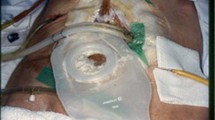Abstract
In 1929, Edgar V. Allen described a noninvasive evaluation of the patency of the arterial supply to the hand of patients with thromboangitis obliterans (Am J Med Sci 1929;178:237). In the early 1950s, Allen's test was modified (Wright I. Vascular diseases in clinical practice. Chicago: Year Book Medical Publishers, 1952) for use as a test of collateral circulation prior to arterial cannulation. This test involves the examiner occluding the patient's ulnar and radial arteries while the patient makes a fist, causing the hand to blanch. The patient is then asked to extend the fingers. After the hand is open, the examiner releases the ulnar artery while continuing to maintain pressure on the radial artery. Adequate collateral circulation is felt to be indicated by return of normal color to the hand. The patient is instructed not to hyperextend the fingers when opening the hand. Hyperextension may cause a decrease in perfusion to the arch, possibly resulting in a false interpretation of the Allen test (Anesthesiology 1972;37:356). The modified Allen's test can be performed quickly and easily, but it is susceptible to error. (With Allen's original test, both hands were tested simultaneously. The patient clenched both fists tightly for 1 minute while the examiner compressed one artery of each hand. This method helps diagnose complete occlusion, just as Allen intended. The test was later modified, however, to evaluate the adequacy of collateral circulation. To perform the modified Allen's test, the examiner compresses both arteries while the patient's fists are clenched. The patient then opens the hand, and the adequacy of circulation is evaluated when the examiner releases one of the arteries.) This study was designed to combine the modified Allen's test with the sensitivity of oximetry and plethysmography to provide a quantifiable and reproducible evaluation of the palmar collateral circulation with or without the subject's cooperation. Superficial palmar arches of 90 normal volunteers (aged 22–45 years) were evaluated with the modified Allen's test. These results were compared with the flow patterns demonstrated by plethysmography and pulse oximetry. All of the modified Allen's tests were normal, with the palmar blush occurring in an average of 2.3 seconds (range, 2–5 s). Results were recorded independently by two observers, with agreement in all cases. Four of the 90 (4.4%) palmar arches were found to have abnormal circulatory patterns. Plethysmography clearly demonstrated the dominant arterial supply to the hand and, in appropriate cases, indicated the existence of an incomplete arch. The four abnormal circulatory patterns (two incomplete palmar arches and two other aberrant arterial communications) were clearly shown by plethysmography. Pulse oximetry was found to be too sensitive. Significant changes in flow did not result in a decrease in saturation. Only the incomplete superficial palmar arches resulted in a change in saturation. The two abnormal arterial communications were not detected by pulse oximetry. Pulse oximetry also could not show dominant flow patterns. Our findings indicate that plethysmography can be used to demonstrate palmar collateral circulation, but that pulse oximetry cannot.
Similar content being viewed by others
References
Doscher W, Viswanathan B, Stein T, Margolis IB. Physiologic anatomy of the palmar circulation in 200 normal hands. J Cardiovasc Surg 1985;26:171–174
Mozersky DJ, et al. Ultrasonic evaluation of the palmar circulation. Am J Surg 1973;126:810–812
Coleman SS, Anson BJ. Arterial patterns in the hand based upon a study of 650 specimens. Surg Gynecol Obstet 1961;113:409–424
Cederholm I, Sorensen J, Carlsson C. Thrombosis following percutaneous radial artery cannulation. Acta Anaesthesiol Scand 1986;30:227–230
Baker RJ, Chunprapaph B, Nyhus LM. Severe ischemia of the hand following radial artery catheterization. Surgery 1976;80:449–457
Katz AM, Birnbaum M, Moylan J, Pellet J. Gangrene of the hand and forearm: a complication of radial artery cannulation. Crit Care Med 1974;2:270–272
Bedford RF, Wollman H. Complications of percutaneous radial artery cannulation. Anesthesiology 1973;38:228–236
Wilkins RG. Radial artery cannulation and ischemic damage: a review. Anaesthesia 1985; 40:896–899
Greenhow DE. Incorrect performance of the Allen's test: ulnar artery flow erroneously presumed inadequate. Anesthesiology 1972;37:356
Gandhi S, Reynolds A. A modification of Allen's test to detect aberrant ulnar collateral circulation. Anesthesiology 1983;59:147–148
Ejrup B, Fischer B, Wright IS. Clinical evaluation of blood flow to the hand. Circulation 1966;33:778–780
Peters KR, Chapin JW. Allen's test—positive or negative? Anesthesiology 1980;53:85
Messick JM. Allen's test—neither negative nor positive. Anesthesiology 1981;54:523
Matsuki A. A modified Allen's test using a pulse oximeter. Anaesth Intensive Care 1988;16:126–127
Cheng EY, Lauer KK, Stommel KA, Guenther NR. Evaluation of the palmar circulation by pulse oximetry. J Clin Monit 1989;5:1–3
Rozenberg RD, Rosenberg M, Birkhan J. Allen's test performed by pulse oximetry. Anaesthesia 1988;43:515–516
Lawson D, Norley I, Korbon G, et al. Blood flow limits and pulse oximeter signal detection. Anesthesiology 1987;75:599–603
Von Nijboer JA, Dorlas JC, Prins JOJ. Beziahung zwischen fotoelektrischem plethysmogramm und volumenpulsation wahrend allgemeinanaesthesie. Anaesth Reanim 1983;5;259–264
Dorlas BJC, Von Nijboer JA. Photo-electric plethysmography as a monitoring device in anaesthesia. Br J Anaesth 1985;57:524–530
Brodsky JB. A simple method to determine patency of the ulnar artery intraoperatively prior to radial-artery cannulation. Anesthesiology 1975;42:626–627
Fuhrman T, Reilley T, Pippin W. Comparison of digital blood pressure (DBP), the modified Allen's test (AT), plethysmography (P), and oximetry (OX) as determinants of collateral blood flow to the hand. Anesthesiology 1990;73:A228
Williams T, Schenken JR. Radial artery puncture and the Allen test. Ann Intern Med 1987;106:164
Slogoff S, Keats A, Arlund C. On the safety of radial artery cannulation. Anesthesiology 1983;59:42–47
Author information
Authors and Affiliations
Additional information
This work was funded by the Anesthesiology Research Foundation and the Samuel J. Roessler Research Scholarship.
This paper was presented at the Society of Critical Care Medicine's 19th Annual Education and Scientific Symposium, San Francisco, California, May, 1990.
Rights and permissions
About this article
Cite this article
Fuhrman, T.M., Pippin, W.D., Talmage, L.A. et al. Evaluation of collateral circulation of the hand. J Clin Monitor Comput 8, 28–32 (1992). https://doi.org/10.1007/BF01618084
Received:
Revised:
Accepted:
Issue Date:
DOI: https://doi.org/10.1007/BF01618084




